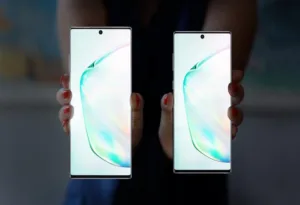Flexible OLED display is considered to be the best solution for next generation smartphone market. New smartphone products with flexible OLED displays generally get rave reviews for their superior display performance. This display technology is gaining shares even in a slow demand market. New capacity is coming, production is increasing, and new products are being launched bringing in new opportunities for flexible OLED displays.

Higher costs, lower yield rates, high prices, and lack of product differentiation, seasonal demand patterns and uncertain economic outlook are creating challenges for stronger growth in demand. More focus on cost reductions, new features, increased product differentiations, new form factors and need for 5G-based models can bring more opportunities for flexible OLED in 2020.
Flexible OLED – Best solutions for next gen smartphones
Flexible OLED display provides the best solution for superior image quality with very high contrast ratio, wider color gamut; faster refresh rates and wide viewing angles. It also enables thin, light, curved, flexible, foldable form factors and design differentiation. In a mature slow demand growth market, smartphone brands are looking for differentiation to drive replacement demand. Samsung’s Galaxy smartphones and Apple’s iPhones flagship products have popularized flexible OLED displays. This technology is poised to dominate the next generation smartphone market with thinner, lighter, bezel less, immersive screens and differentiating form factors. But high costs will limit adoption rates in the near term, especially when most of the growth is coming from lower priced mass-market products.
 Samsung’s Galaxy Note 10
Samsung’s Galaxy Note 10
Rigid OLED and LTPS LCD – Solutions for mass-market products
Samsung, LGE and top Chinese brands are focusing on mass-market products with enhanced features and lower prices (<$500) to capture Asia Pacific and emerging market demand. Samsung Electronics reported in its Q2 2019 result that even when overall market demand for smartphones declined due to the negative macroeconomic environment and seasonal weakness, Samsung’s shipments increased QoQ led by strong sales of new Galaxy A series (mass market models). However, sales of flagship models fell QoQ on weak sales momentum for the Galaxy S10 (flagship product) and stagnant demand for premium products. In the second half of 2019, market demand is expected to stay weak due to growing uncertainties of global economy and trade. Samsung plans to continue to strengthen its flagship lineups and increase sales of new mass-market models. Flagship products are usually served by flexible OLED while rigid OLED or even LTPS LCD enables lower priced mass-market products for most brands.

Flexible OLED- Facing challenges and opportunities
IDC reported on July 31st that worldwide smartphone shipments declined 2.3% YoY in the second quarter of 2019, but it was also the strongest quarterly performance since 2Q18. According to IDC, performance in Q2 indicates demand is starting to pick up as the market begins to stabilize again. A key driver in the second quarter was the availability of vastly improved mid-tier devices that offer premium designs and features while significantly undercutting ultra-high-end price.
Samsung, Huawei, and Apple all lost share while Xiaomi, OPPO, Vivo gained. Samsung, and Apple are top customers for flexible OLED displays. The adoption rate of flexible OLEDs by other Chinese brands depend on competitive panel prices. But most of the brands will focus more on lower priced mass -market products that can be enabled by rigid OLED display or even LTPS LCDs. Slower demand for high end products and higher demand for mid range mass-market consumer product will create challenges for the flexible OLED display in 2019.
IDC’s forecast in May, 2019 showed that the smartphone market is facing another challenging year in 2019 with return to growth on the horizon. IDC expects slow recovery starting from 2020. The company expects smartphone shipments growth in the second half of 2019 driven by 5G acceleration, a growing selection of lower-priced premium handsets, and on-going uplifts from markets like India. It also reported that pricing remains a critical decision factor when purchasing a new handset and this is creating new opportunities for mid-range price points. The focus on mid-range price points will be a challenge but 5G acceleration and new high end product introductions will create new opportunities for flexible OLED.
Flexible OLED – Higher costs, complex manufacturing and lower yield
Flexible OLED displays currently face complex manufacturing challenges and yield management issues resulting in higher production costs. Mass production of thin film encapsulation (TFE) technology from companies such as Kateeva has enabled the elimination of rigid glass to create flexible displays. According to Kateeva’s presentation at DisplayWeek 2019, next generation TFE printing allows for narrower bezels to maximize screen-to-body ratio and supports complex fine pattern printing. The OLED industry is still searching for higher efficiency and longer lifetime materials. R and D in OLED materials and equipment are progressing.
Universal Display Corp (UDC) has been commercially producing phosphorescent OLED materials successfully for many years. PHOLED materials have enabled good power efficiency; increased lifetime and performance improvements in OLED. The industry is still facing challenges due to inefficient blue emitters. OLEDs use red, green and blue emitters. There is a race to provide the most efficient dark blue with long lifetime, which can reduce power consumption and increase lifetime. While the industry is working on better blue phosphorescence, Kyulux is working on a Hyperfluorescence solution while Cynora is working on TADF for emitter technology. Future growth is expected to come from flexible by providing thinner, lighter, unbreakable, flexible lower power and high performance products.
Higher costs, lower yield and long manufacturing times has created a surplus in the market but prices are not coming down aggressively due to custom manufacturing requirements, a low number of suppliers, and higher manufacturing costs. This results in flexible OLED meeting mostly high-end product requirements, but not mass-market consumer needs. Samsung Display dominates the flexible market but LGD and BOE are increasing production and supply. More capacity will also come from companies such as Tianma, Visionox, China Star and others in 2020. This can help to reduce costs and improve adoption rates in 2020.
Flexible OLED – Integration, innovation, and differentiation can help adoption
In a slower smartphone market flexible OLED growth was delayed due to high pricea. Market demand for flexible OLED display-based products from Samsung and Apple are slowing down. This has resulted in lower utilization rates for flexible display and surplus. More shift into foldable display will reduce surplus plus increase demand even though there are still many challenges for foldable smartphone market. Major brands including Samsung and Apple are planning new product launches, which will increase demand.
The introduction of 5G-based products needing slimmer displays to accommodate 5G enabling components will increase flexible OLED demand. Integration of new technology such as fingerprints under display, in cell touch display, hole on display, camera under panel, sound on display, haptics on display, chip on film (COF)/chip on plastic (COP) to reduce border & increase screen to body ratio and foldable display can open up new opportunities for flexible OLED driving growth in demand and increasing adoption rates.
Flexible OLED display will be the best solution for next generation smartphone market with superior image quality, design differentiation, and integration of new features. Manufacturing complexity, lower yield, higher production costs may limit its adoption in the near future especially in slow market in 2019, but 2020 can bring lower cost, higher productions and increased opportunities for flexible OLED display. (SD)
Sweta Dash, President, Dash-Insights
Sweta Dash is the founding president of Dash-Insights, a market research and consulting company specializing in the display industry. For more information, contact [email protected] or visit www.dash-insight.com

